Irrigation Influencing Farmers’ Perceptions of Temperature and Precipitation: A Comparative Study of Two Regions of the Tibetan Plateau
Abstract
1. Introduction
2. Framework
3. Materials and Methods
3.1. Study Area
3.2. Data Collection and Methodology
3.2.1. Climate Data and Analysis
3.2.2. Survey Method
3.2.3. Selection of Variables
4. Results
4.1. Farmer Characteristics
4.2. Change Tends of Temperature and Precipitation
4.3. Farmers’ Perceptionss of Temperature and Precipitation
4.4. Factors Influencing Farmers’ Perceptions of Precipitation Change
5. Discussion
5.1. Climate Change and Farmers’ Perceptions
5.2. Irrigation and Farmers’ Perceptions
5.3. Policy Implications
5.4. Limitations
6. Conclusions
Author Contributions
Funding
Acknowledgments
Conflicts of Interest
References
- Abou Chakra, M.; Bumann, S.; Schenk, H.; Oschlies, A.; Traulsen, A. Immediate Action is the Best Strategy When Facing Uncertain Climate Change. Nat. Commun. 2018, 9. [Google Scholar] [CrossRef] [PubMed]
- Li, C.; Yan, J.; Hua, X.; Zhang, Y. Review on the Sensitivity of Farmers Livelihoods to Climate Change. Progress. Inquis. Mutat. Clim. 2019, 15, 290–300. [Google Scholar] [CrossRef]
- Deutsch, C.A.; Tewksbury, J.J.; Tigchelaar, M.; Battisti, D.S.; Merrill, S.C.; Huey, R.B.; Naylor, R.L. Increase in Crop Losses to Insect Pests in a Warming Climate. Science 2018, 361, 916–919. [Google Scholar] [CrossRef] [PubMed]
- Battisti, D.S.; Naylor, R.L. Historical Warnings of Future Food Insecurity with Unprecedented Seasonal Heat. Science 2009, 323, 240–244. [Google Scholar] [CrossRef] [PubMed]
- Khan, M.R.; Roberts, J.T. Adaptation and International Climate Policy. Wires Clim. Chang. 2013, 4, 171–189. [Google Scholar] [CrossRef]
- Jones, H.P.; Hole, D.G.; Zavaleta, E.S. Harnessing Nature to Help People Adapt to Climate Change. Nat. Clim. Chang. 2012, 2, 504–509. [Google Scholar] [CrossRef]
- Sujakhu, N.M.; Ranjitkar, S.; He, J.; Schmidt-Vogt, D.; Su, Y.F.; Xu, J.C. Assessing the Livelihood Vulnerability of Rural Indigenous Households to Climate Changes in Central Nepal, Himalaya. Sustainability 2019, 11, 2977. [Google Scholar] [CrossRef]
- Beyerl, K.; Putz, O.; Breckwoldt, A. The Role of Perceptions for Community-Based Marine Resource Management. Front. Mar. Sci. 2016, 3. [Google Scholar] [CrossRef]
- Schluter, M.; Baeza, A.; Dressler, G.; Frank, K.; Groeneveld, J.; Jager, W.; Janssen, M.A.; McAllister, R.R.J.; Muller, B.; Orach, K.; et al. A Framework for Mapping and Comparing Behavioural Theories in Models of Social-ecological Systems. Ecol. Econ. 2017, 131, 21–35. [Google Scholar] [CrossRef]
- Hasan, M.K.; Kumar, L. Comparison Between Meteorological Data and Farmer Perceptions of Climate Change and Vulnerability in Relation to Adaptation. J. Environ. Manag. 2019, 237, 54–62. [Google Scholar] [CrossRef]
- Gentle, P.; Maraseni, T.N. Climate Change, Poverty and Livelihoods: Adaptation Practices By Rural Mountain Communities in Nepal. Environ. Sci. Policy 2012, 21, 24–34. [Google Scholar] [CrossRef]
- Panda, A. Exploring Climate Change Perceptions, Rainfall Trends and Perceived Barriers to Adaptation in a Drought Affected Region in India. Nat. Hazards 2016, 84, 777–796. [Google Scholar] [CrossRef]
- Lasco, R.D.; Espaldon, M.L.O.; Habito, C.M.D. Smallholder Farmers’ Perceptions of Climate Change and the Roles of Trees and Agroforestry in Climate Risk Adaptation: Evidence from Bohol, Philippines. Agrofor. Syst. 2015, 90, 521–540. [Google Scholar] [CrossRef]
- Mkonda, M.Y.; He, X.; Festin, E.S. Comparing Smallholder Farmers’ Perception of Climate Change with Meteorological Data: Experience from Seven Agroecological Zones of Tanzania. Weather Clim. Soc. 2018, 10, 435–452. [Google Scholar] [CrossRef]
- Muthuwatta, L.; Perera, H.P.T.W.; Eriyagama, N.; Upamali Surangika, K.B.N.; Premachandra, W.W. Trend and Variability of Rainfall in Two River Basins in Sri Lanka: An Analysis of Meteorological Data and Farmers’ Perceptions. Water Int. 2017, 42, 981–999. [Google Scholar] [CrossRef]
- Hitayezu, P.; Wale, E.; Ortmann, G. Assessing Farmers’ Perceptions about Climate Change: A double-hurdle Approach. Clim. Risk Manag. 2017, 17, 123–138. [Google Scholar] [CrossRef]
- Liu, Z.; Smith, W.J.; Safi, A.S. Rancher and Farmer Perceptions of Climate Change in Nevada, USA. Clim. Chang. 2013, 122, 313–327. [Google Scholar] [CrossRef]
- Mekonnen, Z.; Kassa, H.; Woldeamanuel, T.; Asfaw, Z. Analysis of Observed and Perceived Climate Change and Variability in Arsi Negele District, Ethiopia. Environ. Dev. Sustain. 2018, 20, 1191–1212. [Google Scholar] [CrossRef]
- Mulenga, B.P.; Wineman, A.; Sitko, N.J. Climate Trends and Farmers’ Perceptions of Climate Change in Zambia. Environ. Manag. 2017, 59, 291–306. [Google Scholar] [CrossRef]
- Ayanlade, A.; Radeny, M.; Morton, J.F. Comparing Smallholder Farmers’ Perception of Climate Change with Meteorological Data: A Case Study From Southwestern Nigeria. Weather Clim. Extrem. 2017, 15, 24–33. [Google Scholar] [CrossRef]
- Imran, M.; Shrestha, R.P.; Datta, A. Comparing Farmers’ Perceptions of Climate Change With Meteorological Data in Three Irrigated Cropping Zones of Punjab, Pakistan. Environ. Dev. Sustain. 2018. [Google Scholar] [CrossRef]
- Niles, M.T.; Mueller, N.D. Farmer perceptions of climate change: Associations with observed temperature and precipitation trends, irrigation, and climate beliefs. Glob. Environ. Chang. 2016, 39, 133–142. [Google Scholar] [CrossRef]
- Zhang, D.; Huang, J.; Guan, X.; Chen, B.; Zhang, L. Long-term Trends of Precipitable Water and Precipitation over the Tibetan Plateau Derived from Satellite and Surface Measurements. J. Quant. Spectrosc. Radiat. Transf. 2013, 122, 64–71. [Google Scholar] [CrossRef]
- Yang, L.; Yan, J.; Wang, P.; Wang, H. Impacts of Climate Change on the Reclamation of Farmers and Herdsmen in the Tibetan Plateau. Acta Ecol. Sin. 2019, 39. [Google Scholar] [CrossRef]
- Wang, P.; Yan, J.; Hua, X.; Yang, L. Determinants of Livelihood Choice and Implications for Targeted Poverty Reduction Policies: A Case Study in the YNL Rver Region, Tibetan Plateau. Ecol. Indic. 2019, 101, 1055–1063. [Google Scholar] [CrossRef]
- Taylor, J.G.; Stewart, T.R.; Downton, M. Perceptions of Drought in the Ogallala Aquifer Region. Environ. Behav. 1988, 20, 150–175. [Google Scholar] [CrossRef]
- Le Dang, H.; Li, E.; Nuberg, I.; Bruwer, J. Farmers’ Perceived Risks of Climate Change and Influencing Factors: A Study in the Mekong Delta, Vietnam. Env. Manag. 2014, 54, 331–345. [Google Scholar] [CrossRef]
- Diggs, D.M. Drought Experience and Perception of Climatic Change among Great Plains Farmers. Great Plains Res. 1991, 1, 114–132. [Google Scholar]
- Slegers, M.F.W. “If Only It Would Rain”: Farmers’ Perceptions of Rainfall and Drought in Semi-Arid Central Tanzania. J. Arid Environ. 2008, 72, 2106–2123. [Google Scholar] [CrossRef]
- Howe, P.D.; Thaker, J.; Leiserowitz, A. Public Perceptions of Rainfall Change in India. Clim. Chang. 2014, 127, 211–225. [Google Scholar] [CrossRef]
- Roco, L.; Engler, A.; Bravo-Ureta, B.E.; Jara-Rojas, R. Farmers’ Perception of Climate Change in Mediterranean Chile. Reg. Environ. Chang. 2014, 15, 867–879. [Google Scholar] [CrossRef]
- Alexander, C.; Bynum, N.; Johnson, E.; King, U.; Mustonen, T.; Neofotis, P.; Oettlé, N.; Rosenzweig, C.; Sakakibara, C.; Shadrin, V.; et al. Linking Indigenous and Scientific Knowledge of Climate Change. BioScience 2011, 61, 477–484. [Google Scholar] [CrossRef]
- Green, D.; Raygorodetsky, G. Indigenous knowledge of a changing climate. Clim. Chang. 2010, 100, 239–242. [Google Scholar] [CrossRef]
- Shrestha, U.B.; Shrestha, A.M.; Aryal, S.; Shrestha, S.; Gautam, M.S.; Ojha, H. Climate Change in Nepal: A Comprehensive Analysis of Instrumental Data and People’s Perceptions. Clim. Chang. 2019, 154, 315–334. [Google Scholar] [CrossRef]
- Wu, J.; Qu, J.; Li, H.; Xu, L.; Zhang, H.; Aryal, S.; Zeng, J.; Fan, Y.; Wei, Q.; Liu, X. What Affects Chinese Residents’ Perceptions of Climate Change? Sustainability 2018, 10, 4712. [Google Scholar] [CrossRef]
- Allahyari, M.; Ghavami, S.; Daghighi Masuleh, Z.; Michailidis, A.; Nastis, S. Understanding Farmers’ Perceptions and Adaptations to Precipitation and Temperature Variability: Evidence from Northern Iran. Climate 2016, 4, 58. [Google Scholar] [CrossRef]
- Jessoe, K.; Manning, D.T.; Taylor, J.E. Climate Change and Labour Allocation in Rural Mexico: Evidence from Annual Fluctuations in Weather. Econ. J. 2017, 128, 230–261. [Google Scholar] [CrossRef]
- Denkyirah, E.K.; Okoffo, E.D.; Adu, D.T.; Bosompem, O.A.; Yildiz, F. What Are the Drivers of Cocoa Farmers’ Choice of Climate Change Adaptation Strategies in Ghana? Cogent Food Agric. 2017, 3. [Google Scholar] [CrossRef]
- Couharde, C.; Generoso, R. The Ambiguous Role of Remittances in West African Countries Facing Climate Variability. Environ. Dev. Econ. 2014, 20, 493–515. [Google Scholar] [CrossRef]
- Iqbal, W.; Zahid, M. Historical and Future Trends of Summer Mean Air Temperature over South Asia. Pak. J. Meteorol. 2014, 20, 67–74. [Google Scholar]
- Center, C.M.D.S. Dataset of Monthly Surface Observation Values in China. Available online: http://data.cma.cn/data/cdcdetail/dataCode/SURF_CLI_CHN_MUL_MON.html (accessed on 24 October 2019).
- Zhang, L.; Wei, Y.; Zhou, Q.; Liu, F.; Chen, Q.; Yang, D.; Zhao, P.; Hou, Z. Assessment of the Adaptation Capacity of Famers to Climate Change and Limiting Factor Analysis: A Survey in a Typical Agricultural Area on the Qinghai-Tibet Plateau. Pratacult. Sci. 2019, 36, 1177–1189. [Google Scholar] [CrossRef]
- Zhang, N.; Xiao, T.; Jia, L. Spatial and Temporal Characteristics of Precipitation in the Tibet Plateau from 1979 to 2016. J. Arid Meteorol. 2018, 36, 373–382. [Google Scholar] [CrossRef]
- Wang, C.; Yang, Y.; Pang, W.; Hong, J.; Xie, J. A Review on Farmers’ Perceptions and Adaptation of Climate Change and Variability. Sci. Geogr. Sin. 2017, 37, 938–943. [Google Scholar] [CrossRef]
- Mueller, N.D.; Butler, E.E.; McKinnon, K.A.; Rhines, A.; Tingley, M.; Holbrook, N.M.; Huybers, P. Cooling of US Midwest Summer Temperature Extremes from Cropland Intensification. Nat. Clim. Chang. 2015, 6, 317–322. [Google Scholar] [CrossRef]
- Habtemariam, L.T.; Gandorfer, M.; Kassa, G.A.; Heissenhuber, A. Factors Influencing Smallholder Farmers’ Climate Change Perceptions: A Study from Farmers in Ethiopia. Environ. Manag. 2016, 58, 343–358. [Google Scholar] [CrossRef] [PubMed]
- Soglo, Y.Y.; Nonvide, G.M.A. Climate Change Perceptions and Responsive Strategies in Benin: The Case of Maize Farmers. Clim. Chang. 2019, 155, 245–256. [Google Scholar] [CrossRef]
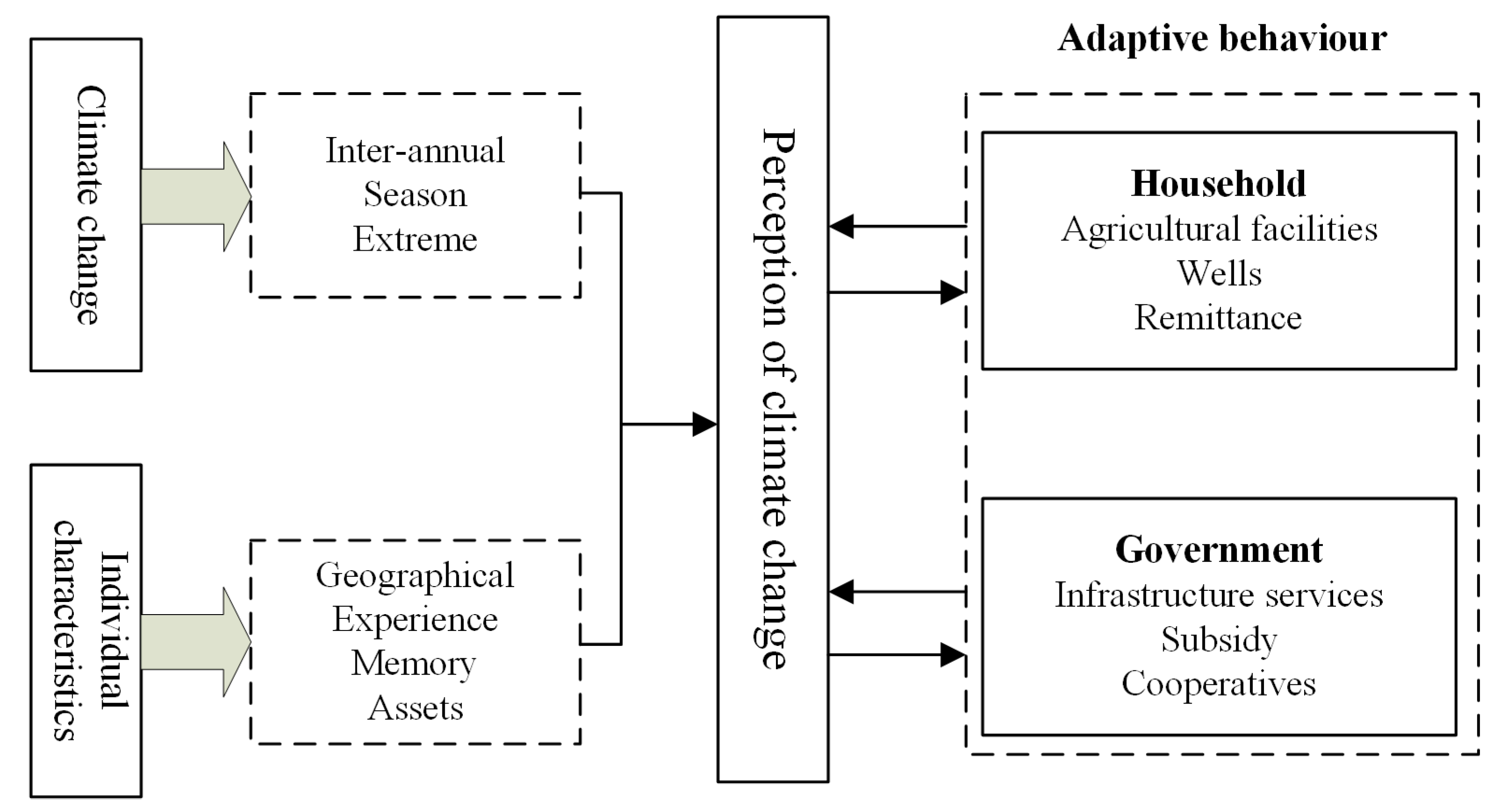
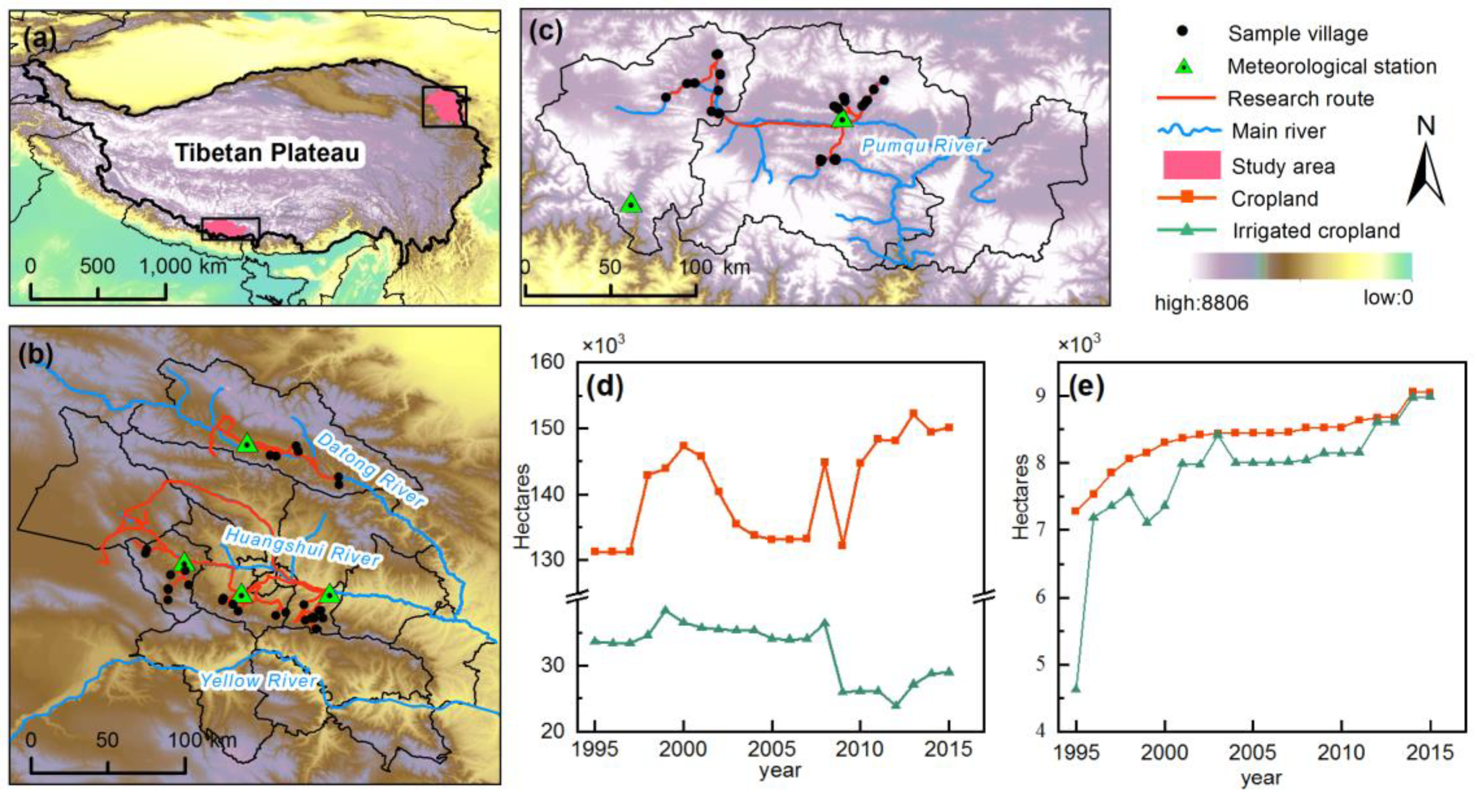
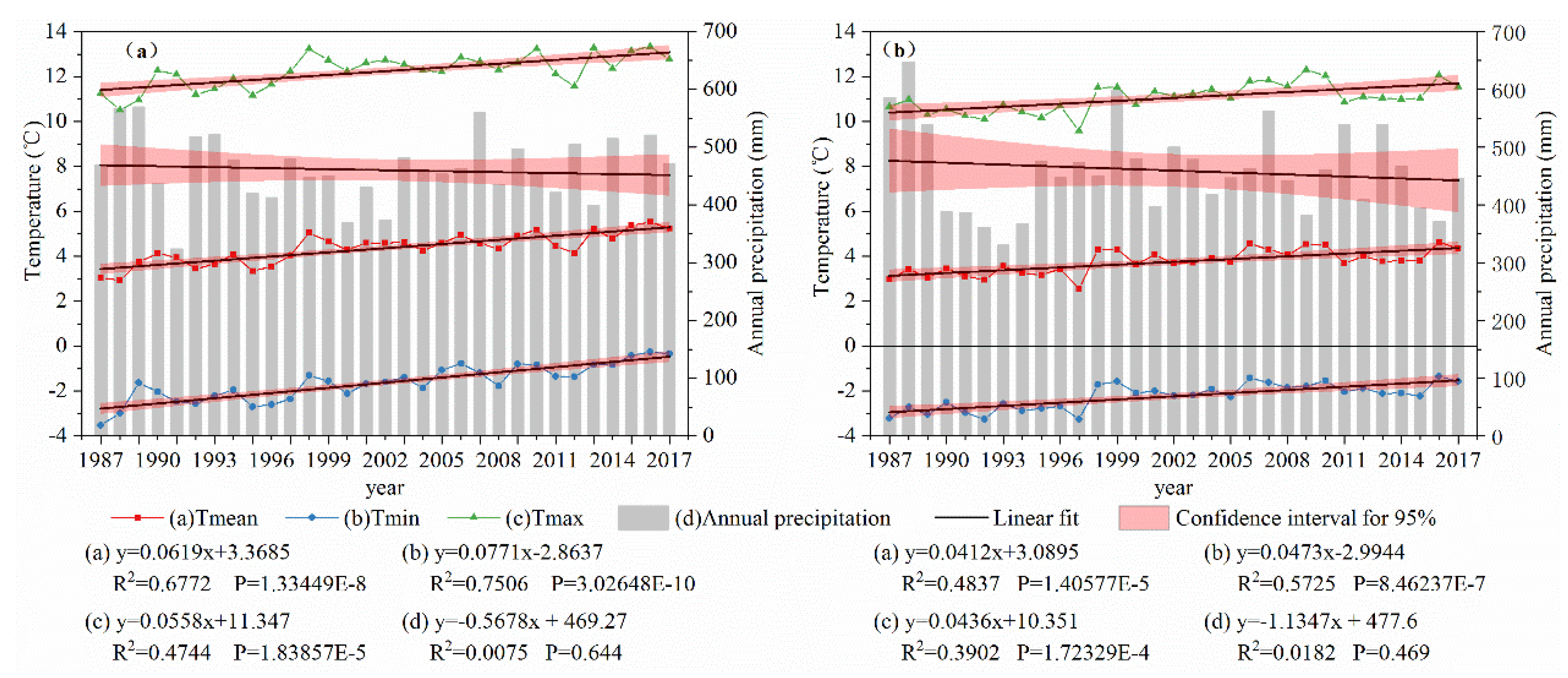
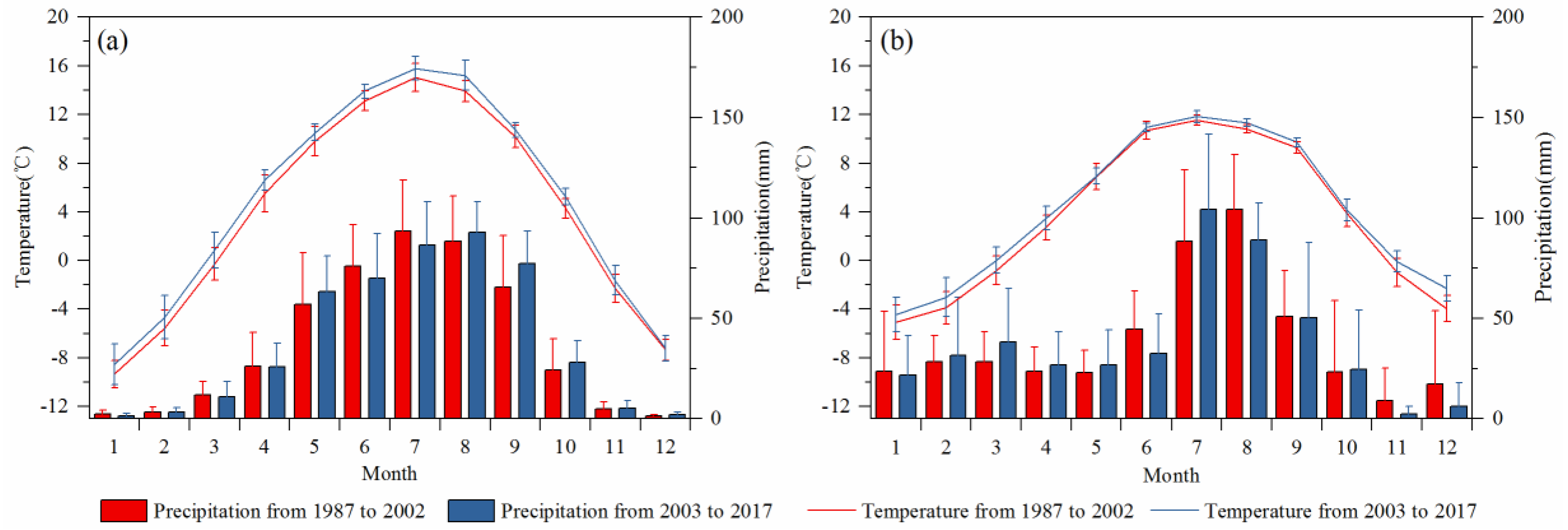
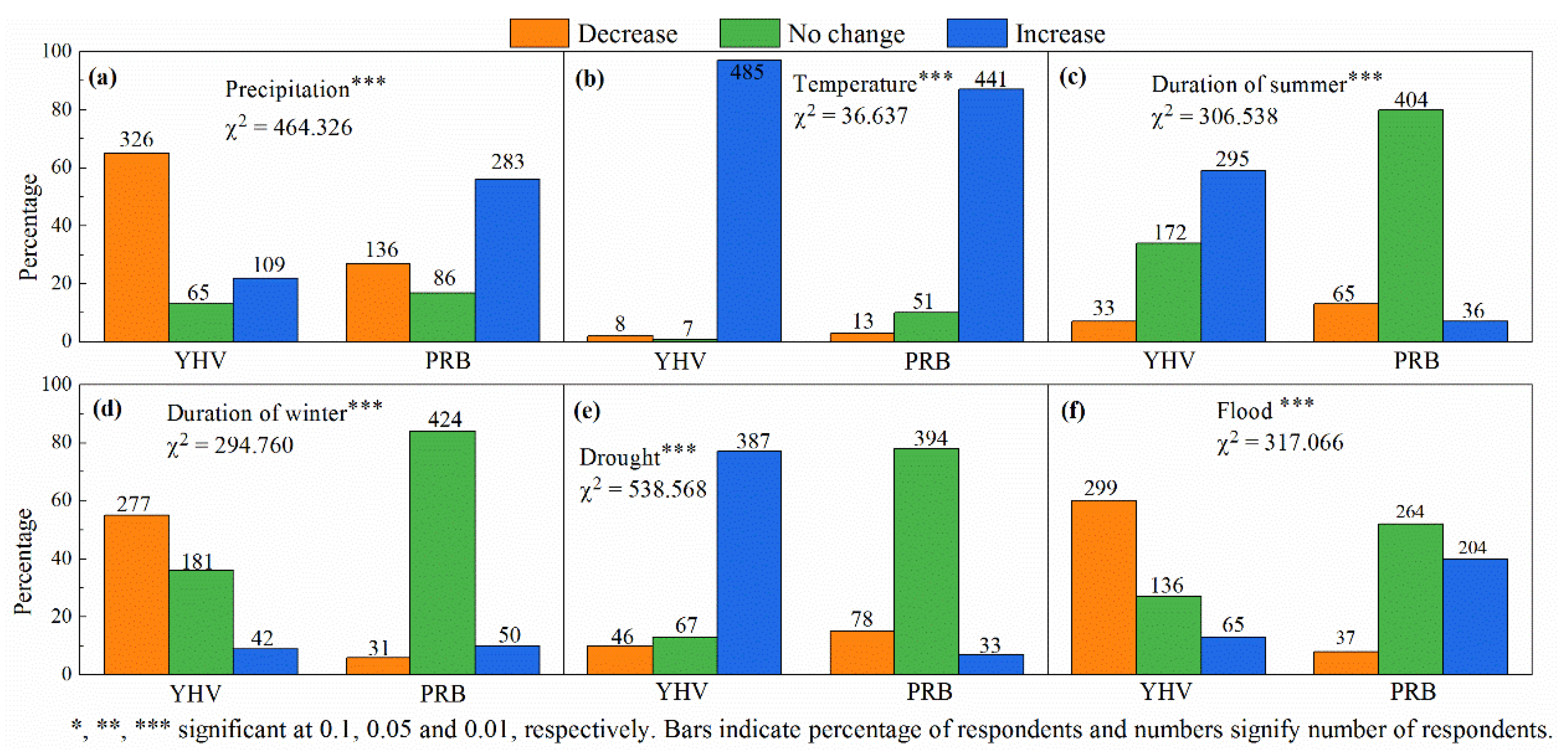
| Name | Region | Long/°E | Lat/°N | Elevation/m | Type | Loss |
|---|---|---|---|---|---|---|
| Huangzhong | YHV | 101.58 | 36.50 | 2667 | General | None |
| Huangyuan | YHV | 101.25 | 36.68 | 2675 | General | None |
| Menyuan | YHV | 101.62 | 37.38 | 2850 | Ordinary | None |
| Ping’an | YHV | 102.10 | 36.50 | 2125 | General | 1986–1988 |
| Tingri | PRB | 87.08 | 28.63 | 4300 | Ordinary | None |
| Nyalam | PRB | 85.97 | 28.18 | 3810 | Base | None |
| Type | Variable | Description | PRB (N = 505) | YHV (N = 500) | Expected Effect | ||
|---|---|---|---|---|---|---|---|
| Mean | S.D | Mean | S.D | ||||
| dependent variable | Farmers’ perceptions of precipitation change | decrease = −1, no change = 0, increase = 1 | 0.78 | 0.22 | −0.43 | 0.68 | |
| geographical location | Regions 1 | Ping’an = 1, Menyuan = 2, Huangzhong = 3, Huangyuan = 4, Tingri = 5, Nyalam = 6 | 5.51 | 0.25 | 2.51 | 1.25 | / |
| Household characteristics | Age of householder | 16~40 = 1, 40~60 = 2, above 60 = 3 | 1.99 | 0.46 | 2.06 | 0.35 | (+) |
| Educational level of householder | Illiterate = 1, primary = 2, middle = 3, high and above = 4 | 1.45 | 0.40 | 1.82 | 0.66 | (+) | |
| Household size | 1~3 = 1, 4~6 = 2, above 6 = 3 | 2.32 | 0.45 | 1.74 | 0.30 | (–) | |
| Community organizations 2 | Whether the household participation community organizations (yes = 1, no = 0) | 1.51 | 0.25 | 1.95 | 0.05 | (+) | |
| Hold irrigated cropland (ha) | 0~0.2 = 1, 0.2~0.67 = 2, above 0.67 = 3 | 2.48 | 0.54 | 1.59 | 0.49 | (?) | |
| Types of irrigation 3 | Rain-fed type = 1, mixed type = 2, ditches type = 3 | 2.37 | 0.35 | 1.68 | 0.74 | / | |
| Adaptive behavior | Wells | Whether the household holds a well (yes = 1, no = 0) | 0.09 | 0.08 | 0.02 | 0.02 | (–) |
| Agricultural facilities 4 | 0~3 = 1, 4~6 = 2, 7~9 = 3 | 1.72 | 0.46 | 1.34 | 0.24 | (+) | |
| Source of potable water | Stream water = 1, tap-water = 2, well water = 3 | 2.19 | 0.51 | 1.97 | 0.03 | (–) | |
| Characteristics | PRB/% | YHV/% | |
|---|---|---|---|
| Age of householder | 16–40 | 23.56 | 14.40 |
| 41–60 | 54.06 | 64.80 | |
| >60 | 22.38 | 20.80 | |
| Educational level of householder | Illiterate | 62.38 | 43.20 |
| Primary | 30.10 | 31.40 | |
| Middle and above | 7.52 | 25.40 | |
| Household size | 1–3 | 11.29 | 31.40 |
| 4–6 | 45.35 | 63.20 | |
| >6 | 43.37 | 5.40 | |
| Hold irrigated cropland (ha) | 0–0.2 | 14.26 | 53.20 |
| 0.2–0.67 | 23.17 | 34.60 | |
| >0.67 | 62.57 | 12.20 | |
| Types of irrigation | Rain-fed type | 5.94 | 58.20 |
| Mixed type | 51.09 | 15.60 | |
| Ditches type | 42.97 | 26.20 | |
| Average elevation of households (m) | 4317.83 | 2883.75 | |
| Participation ratio of community organizations | 48.91 | 35.20 | |
| Independent Variable | YHV | PRB | ||
|---|---|---|---|---|
| χ2 | Gamma (Cramer’s V) | χ2 | Gamma (Cramer’s V) | |
| Regions | 37.535 | 0.299 | 11.570 | 0.035 |
| (0.000) *** | (0.000) *** | (0.003) *** | (0.749) | |
| Age of householder | 1.704 | −0.101 | 2.182 | −0.039 |
| (0.79) | (0.208) | (0.702) | (0.688) | |
| Educational level of householder | 17.564 | 0.237 | 3.356 | 0.054 |
| (0.002) *** | (0.001) *** | (0.500) | (0.606) | |
| Household size | 0.591 | −0.007 | 14.956 | −0.152 |
| (0.964) | (0.943) | (0.005) *** | (0.053) * | |
| Community organizations | 0.988 | 0.044 | 49.173 | 0.298 |
| (0.610) | (0.610) | (0.000) *** | (0.000) *** | |
| Hold irrigated cropland | 10.847 | 0.238 | 14.085 | 0.181 |
| (0.028) ** | (0.001) *** | (0.007) *** | (0.071) * | |
| Types of irrigation | 126.669 | 0.450 | 55.226 | 0.314 |
| (0.000) *** | (0.000) *** | (0.000) *** | (0.000) *** | |
| Wells | 3.526 | 0.084 | 5.081 | 0.1 |
| 0.172 | 0.172 | (0.079) * | (0.079) * | |
| Agricultural facilities | 1.346 | −0.015 | 2.961 | −0.026 |
| (0.853) | (0.870) | (0.564) | (0.787) | |
| Source of potable water | 5.512 (0.064) * | 0.731 (0.006) *** | 55.566 (0.000) *** | 0.315 (0.000) *** |
© 2020 by the authors. Licensee MDPI, Basel, Switzerland. This article is an open access article distributed under the terms and conditions of the Creative Commons Attribution (CC BY) license (http://creativecommons.org/licenses/by/4.0/).
Share and Cite
Wang, T.; Yan, J.; Cheng, X.; Yu, Y. Irrigation Influencing Farmers’ Perceptions of Temperature and Precipitation: A Comparative Study of Two Regions of the Tibetan Plateau. Sustainability 2020, 12, 8164. https://doi.org/10.3390/su12198164
Wang T, Yan J, Cheng X, Yu Y. Irrigation Influencing Farmers’ Perceptions of Temperature and Precipitation: A Comparative Study of Two Regions of the Tibetan Plateau. Sustainability. 2020; 12(19):8164. https://doi.org/10.3390/su12198164
Chicago/Turabian StyleWang, Tao, Jianzhong Yan, Xian Cheng, and Yi Yu. 2020. "Irrigation Influencing Farmers’ Perceptions of Temperature and Precipitation: A Comparative Study of Two Regions of the Tibetan Plateau" Sustainability 12, no. 19: 8164. https://doi.org/10.3390/su12198164
APA StyleWang, T., Yan, J., Cheng, X., & Yu, Y. (2020). Irrigation Influencing Farmers’ Perceptions of Temperature and Precipitation: A Comparative Study of Two Regions of the Tibetan Plateau. Sustainability, 12(19), 8164. https://doi.org/10.3390/su12198164





